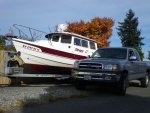I've been following this thread and I'm somewhat surprised as to what lengths people are going. The true test is: everything stable while hauling and do the tires show any abnormal wear?
The thread started with "what is best?". It is best to have the loads on both axles close as possible to being equal. (the assumption is that axles are properly placed). As below, you won't know if there is tire wear, until it is visible. Best to try and prevent the wear.
For me the measurement is at the rear and front of the Aluminum "I" beam on the trailer frame. So after Bori's question about how to measure:
When I look at it there's a curve from the hitch to where the tongue attaches. I couldn't get a level to less than a couple of inches. How are you measuring 3/4"?
I used both visual sighting, and a laser beam to check, and if there is any sag in the Aluminum beam on the 22 Trailer, it is less than 1/8". You measure the "level" as the tow vehicle is loaded, and on a flat, level surface. This is the advantage of an adjustable ball hitch.
I have had the misfortune to fry a bearing on a hub, probably due to dragging calipers on a long down grade with surge brakes (C Dory 25). There are enough stories and trailers along the side of the road, to make it a prudent, and routine to check the hub temps--even if the bearings are repacked before any significant haul (as mine are). It takes couple of minutes (good exercise) to walk around a trailer, and take IR temps on the hubs, calipers and tires. We do this regularly every two hours--the only time I had a problem was when we violated this rule because of traffic and lack of a place to stop and check.
With a single axle trailer, the "level" is not as critical.
Sunbeam, it would have been interesting to see what the hitch weight was--since your two axles weight was 3700 lbs--was the hitch weight over 500 lbs?
I think most people's trailer tires age out before they wear out. The tires on my trailer are about out of time based on age, but the tread looks pretty new.
This is most likely true--but of course it depends on how much you tow the trailer each year. C Dory owners may be more frequent travelers, due to the nature of our boats and life styles. We tend to put from 4,000 to 8,000 miles a year on the boat trailer, but the average boater is probably a few miles back and forth to a ramp. On the C Dory 25 the first set of tires was shot in about 7500 miles. Earlier I had posted that there seemed to be little difference in wear between the tires--until I put the micrometer on the tread depth! I suspect that these bias Chinese tires will not last over 10,000 miles (even being leveled)--or a couple of years--the next ones will be radials. On our RV, we put over 60,000 miles when the tires timed out--at 6 years, and there was plenty of tread left. I know that some tire dealers sell these tires to on the road truckers for their trailers (although my dealer claimed he didn't).

